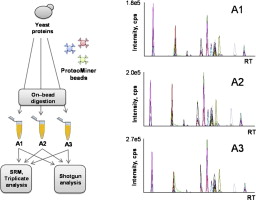Paper accepted
Congratulations to Francesco, Martin, Yuehan and Paola; their paper "Reproducibility of combinatorial peptide ligand libraries for proteome capture evaluated by selected reaction monitoring" was accepted for publication in Journal of Proteomics!

Abstract
Systems biology studies require the capability to quantify with high precision proteins spanning a broad range of abundances across multiple samples. However, the broad range of protein expression in cells often precludes the detection of low-abundance proteins. Different sample processing techniques can be applied to increase proteome coverage. Among these, combinatorial (hexa)peptide ligand libraries (CPLLs) bound to solid matrices have been used to specifically capture and detect low-abundance proteins in complex samples. To assess whether CPLL capture can be applied in systems biology studies involving the precise quantitation of proteins across a multitude of samples, we evaluated its performance across the whole range of protein abundances in Saccharomyces cerevisiae. We used selected reaction monitoring assays for a set of target proteins covering a broad abundance range to quantitatively evaluate the precision of the approach and its capability to detect low-abundance proteins. Replicated CPLL-isolates showed an average variability of ~10% in the amount of the isolated proteins. The high reproducibility of the technique was not dependent on the abundance of the protein or the amount of beads used for the capture. However, the protein-to-bead ratio affected the enrichment of specific proteins. We did not observe a normalization effect of CPLL beads on protein abundances. However, CPLLs enriched for and depleted specific sets of proteins and thus changed the abundances of proteins from a whole proteome extract. This allowed the identification of ~400 proteins otherwise undetected in an untreated sample, under the experimental conditions used. CPLL capture is thus a useful tool to increase protein identifications in proteomic experiments, but it should be coupled to the analysis of untreated samples, to maximize proteome coverage. Our data also confirms that CPLL capture is reproducible and can be confidently used in quantitative proteomic experiments.
